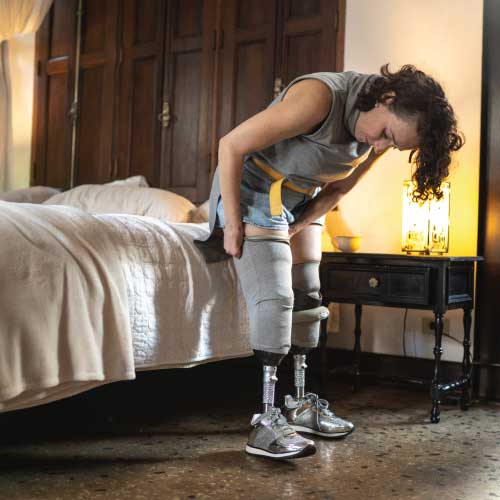4 Smart Prosthetic Sockets That Are Worth the Wait
Despite advances in prosthetic technology, one critical feature has yet to be upgraded—the prosthetic socket.

The prosthetic socket connects the residual limb to the prosthetic limb, making it an essential aspect of a prosthetic system. So far, technological advancement has only produced powered knees and feet, but these are useless without a good-fitting prosthetic socket.
Lower-limb amputees can recount the familiar frustrations associated with volume change in their residual limbs and its drastic effect on socket fit and alignment. Many have mastered the logistics required by multiple sock changes and other adjustments to add or reduce thickness, only to end in a pistoning socket that causes blisters, sore spots, and rashes, among others.
Furthermore, many lower-limb amputees can attest to the other effects of an ill-fitting socket in the form of pain in the back, hip, and knee. There are other issues, too, like loss of circulation due to a socket that’s too tight, leading to the immediate removal of the prosthetic limb.
These issues can be too much to handle for some prosthetic leg users. An Agency for Healthcare Research and Quality 2019 report estimated that 11% to 22% of lower-limb amputees end up abandoning their prosthetic limbs after about a year.
Fortunately, better days may lie ahead as smart prosthetic sockets are on the horizon. These smarter prosthetic sockets hold the potential to reduce or eliminate all of these problems.
AI prosthetic liner
London-based start-up UNHINDR is currently developing Roliner, the much-awaited first-ever prosthetic liner that uses artificial intelligence (AI) to adapt to the user’s residual limb. It also learns the user’s preferences over time to continuously adjust the liner’s fit without much manual input.
Like any other prosthetic liner, Roliner is made from silicone, can be cut to size, and is washable. It can also be used with any existing prosthetic socket.
Although Roliner isn’t available to consumers yet, it’s making steady progress. The UNHINDR team has already filed several patents and launched prototype trials. A national clinical trial is expected to begin in the UK in early 2022.
The good news is that UNHINDR wants to keep Roliner affordable, which means they might offer different versions of the product at various price points.
Motor-driven prosthetic sockets
After dedicating more than 25 years to improving the fit of prosthetic devices, Joan Sanders, a bioengineering professor at the University of Washington, and her team have been working on smart prosthetic sockets.
They currently have two projects. The first is a motor-driven auto-adjusting prosthetic socket that lets individuals wear their prosthetic limbs during high-intensity activities without worrying about discomfort or pain. This is because the smart socket can make minute adjustments throughout the day, which keeps users comfortable. The project has since moved into clinical trials.
The second is an innovative prosthetic socket technology developed in collaboration with the Army’s Center for the Intrepid. The product, called a release-relock socket, is being tested under demanding military conditions.
In a nutshell, the release-relock socket allows the user to release socket pressure while sitting without losing contact with the prosthetic limb. With a push of a button, the socket can be donned, partially donned, or removed.
Pilot testing for the release-relock socket has concluded, and clinical trials are underway. There’s also a second generation of the technology currently in development.
Smart materials make an intelligent socket
Researchers at Virginia Tech used smart materials used initially to develop morphing airplane wings to create a smart prosthetic socket. The material, called flexible fluidic matrix composites, can change volume and stiffness, perfect for accommodating residual limb volume fluctuations.
The prototype was developed with input from Trevor LeMaster, a mechanical engineer from Virginia Tech and a congenital above-knee amputee.
This smart prosthetic socket may take a while to be ready for consumers. A prototype may be expected in 2022, and testing will begin in 2023.
Which of these innovations do you find promising?











































































